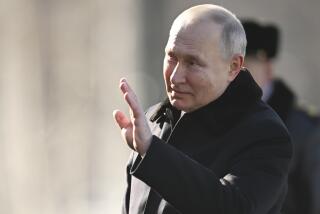Arms Treaty Foes Distort Soviet Record
- Share via
MANCHESTER, MASS. — There are bad days ahead for arms control. The ashes of the failed Iceland summit have grown cold; the Geneva arms talks have recessed; the end of the year is approaching and Ronald Reagan has made good his threat to scrap SALT II, the 1979 arms-control treaty he called “fatally flawed” in his 1980 campaign and then went on to observe, if not to honor, for six more years.
To justify his action--on the day after Thanksgiving, while media and public attention were focused on the growing Iran scandal--the White House claims that the Soviets have routinely violated SALT II and other arms-control treaties. To reinforce this message, each December the White House issues a dramatic report detailing alleged Soviet transgressions. The focus of this year’s report is expected to be a replay of earlier charges that the Soviets have built more and larger new types of missiles than SALT allows, and are encoding radio signals from missile tests in ways not permitted by the treaty.
There has been little public objection to these reports. For many Americans, conditioned by years of Cold War disinformation, it is almost an article of faith that the Soviet Union routinely violates arms treaties. Suggestions that the Soviets have largely been abiding by SALT II, and may be doing so today, are generally not believed. If true, they would not be convenient for the Administration’s case against SALT.
That is the principal reason SALT opponents in the Administration have persistently belittled, and have now essentially destroyed, the Standing Consultative Commission (SCC)--the one institution that might effectively confirm or disprove charges of Soviet cheating.
The Strategic Arms Limitation Treaties, SALT I and II, cover a range of technical detail seldom seen in any international agreement. Of particular importance are the treaties’ extensive details concerning verification--how to give each party confidence that the other is living up to the treaty’s terms. These provisions include prohibitions against interference with photographic satellites and other technical surveillance, bans on concealment and creation of agreed data bases.
By far the most innovative verification provision in SALT, however, is the Standing Consultative Commission. Composed of senior American and Soviet military, diplomatic, scientific and intelligence experts, this little-known body has met twice a year since 1972 to resolve questions about compliance that may arise. It has also served as the forum for interpreting ambiguous treaty provisions and for establishing procedures for dismantling missile silos or missile launching submarines to keep within the numbers set by SALT.
The SCC was a valuable institution from the start. Through its quiet deliberations a number of questionable practices by both sides have been systematically analyzed and resolved to the satisfaction of both parties. The proceedings are generally kept secret by mutual agreement, but a State Department report published in 1979 provided a glimpse. It detailed the record of the previous seven years: eight cases where there were U.S. concerns about Soviet compliance and six where the Soviets raised questions about U.S. compliance. All were satisfactorily resolved in the SCC.
Resolution came to a halt with the Reagan Administration, where hard-liners are bent on dismantling the arms-control treaty structure as soon as possible. They are contemptuous of suggestions that they seek out the facts about alleged violations, for fear the truth would be less damning than their indignant accusations suggest.
Gen. Richard Ellis, the U.S. SCC commissioner, has been ordered, by Defense Secretary Caspar W. Weinberger, to use the SCC solely for the purpose of accusing the Soviets of violating SALT, and has been expressly prohibited from exploring questionable practices with them. In 1985 Weinberger scornfully derided the SCC process as “a diplomatic carpet under which Soviet violations have been continuously swept, an Orwellian memory hole into which our concerns have been dumped like yesterday’s trash.”
The SCC has become a joke, no longer a forum where ambiguities about the size and type of Soviet missiles can be discussed, or questions about the degree to which the Soviets code their missile test data can be examined.
The Reagan Administration clearly does not want those questions answered. Its main interest is in abandoning arms control as expeditiously as it can. Trashing the SCC is one good way to keep the facts at bay and the accusations as lurid as possible.
Working in the Arms Control Agency in Washington, I occasionally met with Soviet officials. Once, over lunch, I asked a Soviet diplomat, one of his government’s first delegates to the SCC, what he thought of the commission; in particular what he thought about its value as a precedent for future arms agreements. He put down his fork and thought a minute, groping for the right word. He raised his hand from the table, palm up, fingers extended as if supporting a rare, beautiful, but fragile object.
“It is a crystal,” he said.
More to Read
Sign up for Essential California
The most important California stories and recommendations in your inbox every morning.
You may occasionally receive promotional content from the Los Angeles Times.













